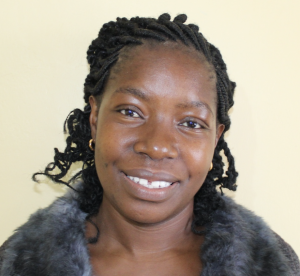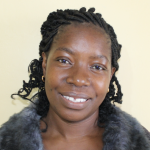"We have always wanted to construct a bigger [rain] tank that is able to serve the school with clean and reliable safe water, but it is too expensive for us [alone]. Cases of stomach upsets are rampant as a result of consuming contaminated water from unknown sources. We will be happy if this WaSH project is implemented so that we can access clean and safe water and stop cases of absenteeism caused by waterborne and water-related diseases," said Deputy Head Teacher of St. Joakim Buyangu Primary School, Mr. Wycliffe Mukiling'ani.
St. Joakim Buyangu Primary School is a public mixed primary school that was established in 1960, sponsored by the Catholic Church. Beginning with just 30 pupils, now the school hosts 360 pupils and 15 teachers and staff every day, and yet they rarely have water available on campus.
The only source of water at school is a small plastic rain tank with just 8,000-liters volume - quite insignificant when this water is needed for the entire school population's daily drinking, cooking, and cleaning needs.
Pupils scramble for the little water this tank has to give, and in the process they sometimes get hurt. No rain for just 3 consecutive days means the tank runs dry, forcing pupils to carry water from home every morning and after lunch. Each walk is tiresome and time-consuming for the pupils as they also need to carry their books to school. When students finally get back to class, they are often too tired to focus well, negatively impacting their academic performance. Even with students bringing water from home, however, the school has to severely ration their water usage.
At Buyangu Primary, the quantity of water is not the only challenge; the safety and quality of water in school has been an ongoing issue as well. The small rain tank has never been cleaned in the years since its installation, and there is no method for treating the water once students fetch it. The water pupils bring from home is even worse since not everyone observes hygienic practices when handling the water. Upon a quick spot check, the jerrycans the pupils use to carry water are dirty and some of the water they fetch comes from contaminated sources.
Pupils frequently contract waterborne and water-related diseases like typhoid and diarrhea after drinking water at school, whether it originated from the little tank or home. Since students combine water for use at school, even 1 contaminated source or dirty container means everyone is at an elevated risk for waterborne diseases. When pupils or teachers get sick, it means more missed class time and lower grades.
Since water is at the heart of maintaining good hygiene and sanitation, the situation is wanting at this school. There are no dishracks or handwashing stations. The latrines in use are dirty and smelly since they can only be cleaned once a week, and some are already full. None have lockable doors.
"Our latrines are always dirty and I don't feel comfortable using them but I have no choice since we don't have an alternative. If we had sufficient water in the school, we would be able to wash our latrines and classes every day and wash our hands after using the latrines. We would also have clean and safe water to drink and for general use," said pupil Juliet.
What We Can Do:
Rain Tank
A 75,000-liter rainwater catchment tank will help alleviate the water crisis at this school. The school will help collect the needed construction materials such as sand, bricks, rocks, and water for mixing cement. We will complement their materials by providing an expert team of artisans, tools, hardware, and the guttering system. Once finished, this tank will begin catching rainfall that will be used by the school’s students and staff for drinking, handwashing, cooking, cleaning, and much more.
We and the school strongly believe that all of these components will work together to improve standards at this school, which will help lead to better student academic performance and will help to unlock the potential for these students to live better, healthier lives.
Handwashing Stations
There is currently nowhere for students to wash their hands after using the latrines or before eating lunch, let alone the water to do so.
The student health club will oversee the 2 new handwashing stations we will provide, and make sure they are kept clean and in working condition. The club leaders will fill the handwashing stations with water daily and make sure they are always supplied with a cleaning agent such as soap or ash.
VIP Latrines
2 triple-door latrine blocks will be constructed with local materials that the school will help gather. 3 doors will serve the girls while the other 3 will serve the boys. All of these new latrines will have cement floors that are designed to be easy to use and to clean. And with a rain tank right on school property, there should be enough water to keep them clean.
Training on Health, Hygiene, COVID-19, and More
We will hold a 1-day intensive training session with students, teachers, and parents. This training will cover a wide range of topics including COVID-19 symptoms, transmission routes, and prevention; personal and environmental hygiene; and the operation and maintenance of the rain tank, latrines, and handwashing stations. There will be a special emphasis on handwashing.
Our team of facilitators will use a variety of methods to train, including participatory hygiene and sanitation transformation, and asset-based community development. We will initiate a student health club, which will prepare students to lead other pupils into healthy habits at school and at home. We will also lead lectures, group discussions, and provide illustrative handouts to teach health topics and ways to promote good hygiene practices within the school including handwashing and water treatment. We will then conduct a series of follow-up trainings before transitioning to our regularly scheduled support visits throughout the year.

 Rainwater Catchment
Rainwater Catchment
 Rehabilitation Project
Rehabilitation Project

























 We officially handed over the rain tank to the school directly following the training. Students and staff celebrated the presence of clean water on campus. The event was an excellent chance for us to acknowledge the school administration and students as the primary parties entrusted with the tools we have given and remind them of our continued support as they develop. Happiness, thanksgiving, and appreciation were the order of the day flowing in all directions.
We officially handed over the rain tank to the school directly following the training. Students and staff celebrated the presence of clean water on campus. The event was an excellent chance for us to acknowledge the school administration and students as the primary parties entrusted with the tools we have given and remind them of our continued support as they develop. Happiness, thanksgiving, and appreciation were the order of the day flowing in all directions.

















